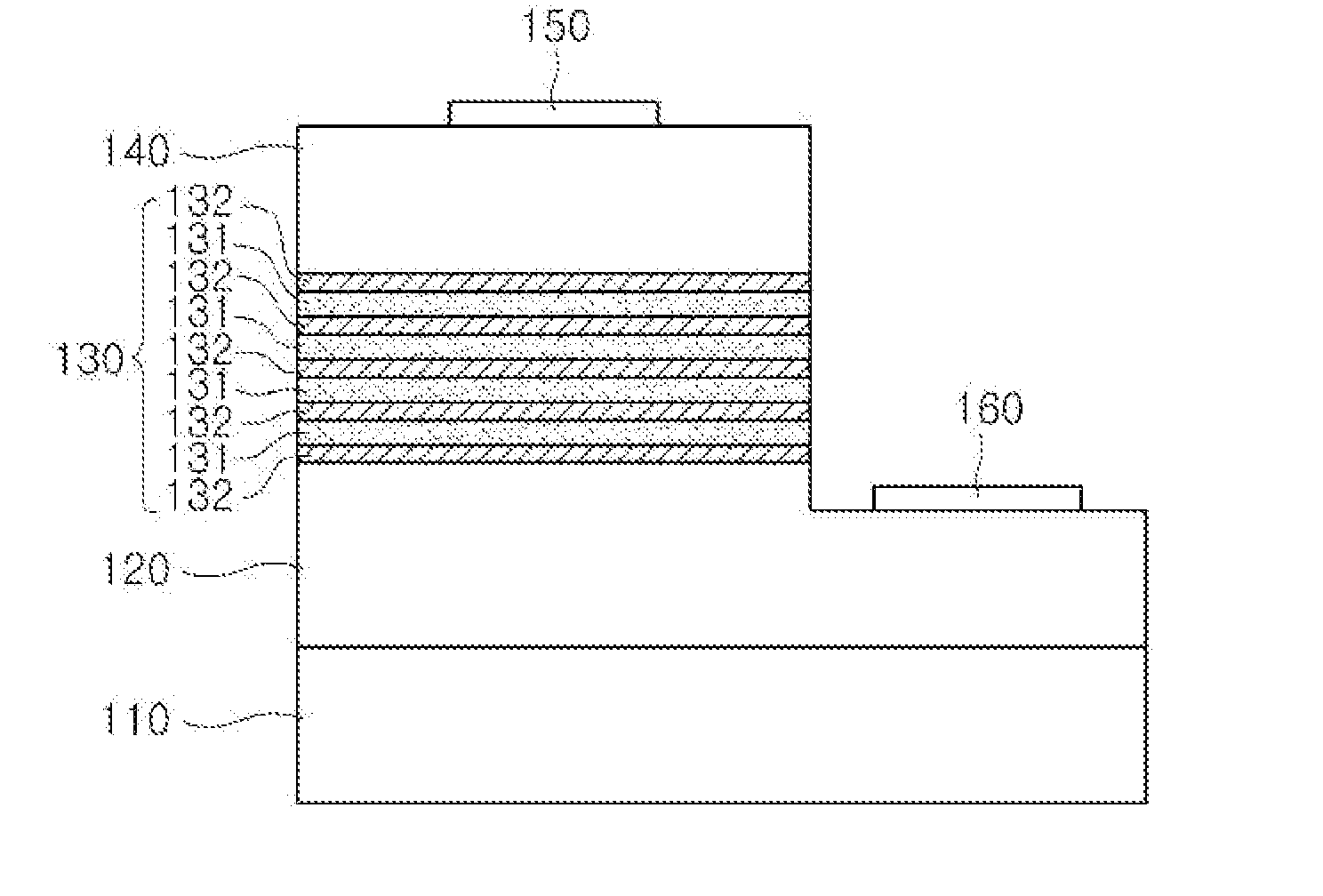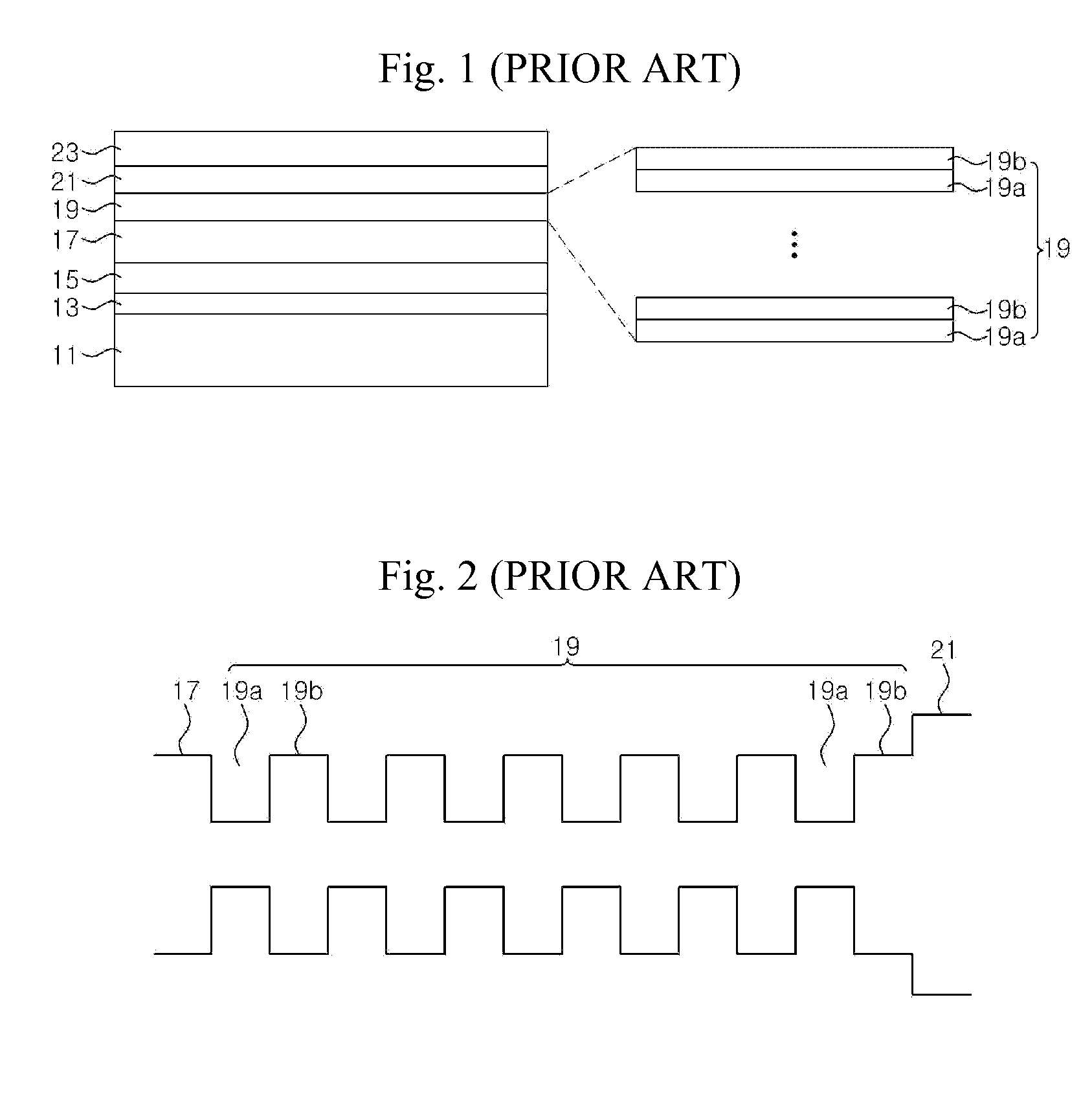Light emitting diode having active region of multi quantum well structure
a light-emitting diode and active region technology, applied in the field of light-emitting diodes, can solve the problems of reducing the luminous efficiency of led, dislocation, cracking or warpage of semiconductor layers, etc., and achieves the effect of improving the luminous efficiency and increasing the recombination rate of electrons and holes
- Summary
- Abstract
- Description
- Claims
- Application Information
AI Technical Summary
Benefits of technology
Problems solved by technology
Method used
Image
Examples
first embodiment
[0083]FIG. 7 is a band diagram illustrating an active region of a multi quantum well structure according to a modification of the present invention.
[0084]Referring FIG. 7, a middle barrier layer 59c having a bandgap relatively wider than the first and n-th barrier layers 59b-1 and 59b-n is positioned therebetween as described with reference to FIG. 6. In addition thereto, other middle barrier layer 59c′ having a bandgap relatively wider than the first and n-th barrier layers 59b-1 and 59b-n is positioned therebetween. The other middle barrier layer 59c′ may be positioned between the first barrier layer 59b-1 and the middle barrier layer 59c.
[0085]Like the middle barrier layer 59c, the other middle barrier layer 59c′ has a relatively wide bandgap and therefore restricts the movement of electrons. Particularly, if the other middle barrier layer 59c′ is disposed close to the middle barrier layer 59c, the recombination rate of electrons and holes is more increased. In addition, as show...
second embodiment
[0100]However, in the LED according to the present invention, since the barrier layer 79b close to the N-type compound semiconductor layer 57 has a narrower bandgap than the barrier layer 79d close to the P-type compound semiconductor layer 63, the band slope of the barrier layers may be decreased even though a high forward voltage is applied to the LED. Particularly, if a forward voltage is applied to the LED, the bandgap of the barrier layers 79b, 79c and 79d can be controlled so that the conduction bands of the barrier layers are positioned at the generally same energy level. Accordingly, removing the driving force inducing carrier overflow in the active region 79 and improving the recombination rate of electrons and holes are possible.
[0101]Although the three barrier layers 79b, 79c and 79d have been shown and described in the second embodiment of the present invention, the present invention is not limited thereto. That is, a larger number of the barrier layers may be alternatel...
third embodiment
[0104]FIG. 13 is a sectional view illustrating an LED having an active region of a multi quantum well structure according to the present invention. The LED according to this embodiment has the generally same laminated structure as the LED described with reference to FIG. 5, which will be described in brief. Only the differences will be described in detail.
[0105]Referring to FIG. 13, an N-type semiconductor layer 120, an active region 130 and a P-type semiconductor layer 140 are laminated and formed on a substrate 110. A P-electrode 150 is formed on the P-type semiconductor layer 140. After a predetermined region of the N-type semiconductor layer 120 is exposed through a mesa etching process, an N-electrode 160 is formed on the exposed N-type semiconductor layer 120.
[0106]The active region 130 is formed to have a multiple quantum well structure by alternately laminating well layers 131 having a narrow energy bandgap and barrier layers 132 having an energy bandgap wider than the well ...
PUM
 Login to View More
Login to View More Abstract
Description
Claims
Application Information
 Login to View More
Login to View More - R&D
- Intellectual Property
- Life Sciences
- Materials
- Tech Scout
- Unparalleled Data Quality
- Higher Quality Content
- 60% Fewer Hallucinations
Browse by: Latest US Patents, China's latest patents, Technical Efficacy Thesaurus, Application Domain, Technology Topic, Popular Technical Reports.
© 2025 PatSnap. All rights reserved.Legal|Privacy policy|Modern Slavery Act Transparency Statement|Sitemap|About US| Contact US: help@patsnap.com



